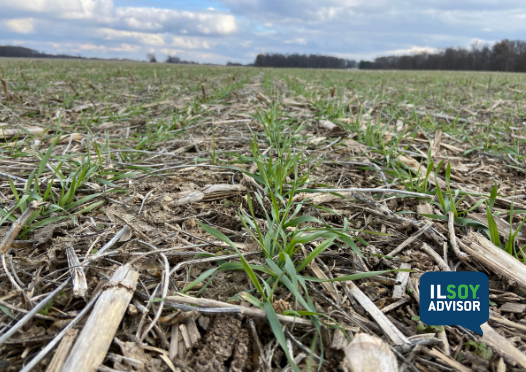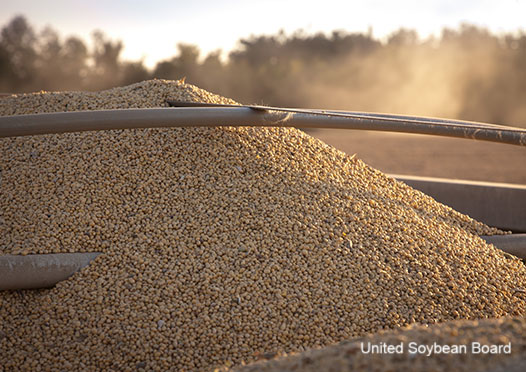ILSOYADVISOR POST
Do RR2 and Liberty Link Soybeans Still Work?
Weed control has gotten tougher and more complicated over the past 10 years. When Roundup Ready® soybeans were first introduced back in 1996, 20 years ago, glyphosate was a one-stop weed control solution. One or two passes were all that it took. But it didn’t take long for weeds to become resistant to glyphosate. The first species, rigid ryegrass, already showed resistance in 1996, Italian ryegrass developed resistance in 2001 and perennial ryegrass in 2008. Now there are 36 weed species that are resistant to glyphosate. And today in Illinois we deal with marestail, waterhemp, Palmer amaranth and ragweed.
For more than 15 years growers only had to decide on one weed control trait, glyphosate resistance of Roundup Ready, now succeeded by Roundup Ready 2. That was the only trait and 90 percent of the acres and the majority of varieties have carried this trait. Today glyphosate still plays a role in controlling common grass weeds and some broadleaf weeds. But its application has to be combined with a preresidual and probably a postresidual.
But today that decision is more complicated with the availability of Liberty Link® (resistant to glufosinate), Roundup Ready® Xtend (resistant to Xtendimax® dicamba herbicide and combined with glyphosate) and perhaps next year Enlist E3™ soybeans (resistant to 2,4-D herbicide and combined with glyphosate).
An Illinois grower submitted an intriguing question. “It really is interesting the big decisions that soybean farmers are looking at this winter regarding soybean seed selection. Will Roundup Ready 2 still work? Do you have too much waterhemp and is it resistant to glyphosate? Will you go to Liberty beans? What is the expected yield from those? Will you try Xtend and what is the expected yield from those?” Will Liberty and Xtend herbicides be readily available and what will they cost?”
These are all good questions and topics to consider when you make trait decisions this year.
Really the first decision is based on your weed pressure—if resistant weeds are a big component of that pressure, if your chemical program isn’t cutting it anymore and waterhemp, Palmer and ragweed aren’t being controlled. If weed control has become your big challenge and a stacked weed control system with multiple herbicide families isn’t working, it’s time to consider adopting one of these new traits.
Of course one of the big questions growers ask about is yield. I think we remember back to when Roundup Ready was first introduced—yield was subpar compared to the most recent conventional varieties. Yes there was yield drag; I believe a lot of lessons were learned and that mistake isn’t being repeated. But when buying a variety with a new trait, do your duty and make sure it adapted, has the right defensive package and yields near the top of its class.
Will Roundup Ready 2 (RRY2) still work? Lance Tarochione, agronomist with Monsanto in Western Illinois answers this question. “Complex topic with many different layers. The short answer to his question is ‘YES … with a lot of buts.’” Tarachione continues by saying that without knowing details of the reader’s operation and weed issues it is hard to get specific, but he has some thoughts in general:
1) Roundup still controls most weed species as well as it ever has. Obviously, resistance in important species like waterhemp must be managed with other chemistry but it is worth noting that important species like all grasses, perennial weeds, lambsquarters, velvetleaf and many, many others are still controlled more effectively by Roundup than any other chemistry.
2) Resistant species like waterhemp and marestail can be effectively controlled using other chemistry in a RR2Y program.
- There are many soil-applied products and multiple modes of action with good activity on waterhemp but I will not specify commercial products by name.
- Aaron Hager at the University of Illinois is a good resource to compare the efficacy of different chemistry options on specific weeds.
- Keep in mind that in some areas PPO resistance is prevalent in waterhemp also, so postapplied PPO chemistry may have minimal benefit. The best way to control resistant waterhemp in a RR2Y program is to never let it come up.
3) Resistant species can also be managed by changing to other platforms like Roundup Ready Xtend or Liberty Link.
- All programs have different strengths and weaknesses and all programs should include multiple modes or action and the use of conventional residual chemistry.
- Relying on any postemergence program to give 100 percent control of waterhemp is risky, unsustainable and not likely to provide satisfactory results.
4) Good weed management recommendations for RR2Y, Roundup Ready Xtend and Liberty Link systems should ALL involve pre and postresidual chemistry today.
5) Soybean weed control is not as simple or cheap as it was 10 – 15 years ago; this is a reality that is here to stay. There is no system we can choose today that is as easy or economical as Roundup Ready was for many years.
Liberty Link and Liberty herbicide is another option that growers can use as long as they learn to manage the Liberty application to maximize efficacy.
1) With all the weed resistance should we try to go Liberty beans? We have too much waterhemp that seems uncontrollable.
- Even if you don’t have resistant waterhemp on your farm—which is unlikely since it is so prevalent—it makes sense to not only change herbicide sites of action, but to use multiple sites of action to slow the development of resistant weeds to ANY herbicide site of action. A study from the University of Illinois concluded that using two effective sites of action reduced the chances of weeds becoming resistant by 83 percent. This is why with the LibertyLink system we recommend using a 2––site of action preemergence residual product and then come back with Liberty herbicide plus a postresidual herbicide. Your local retailer will have their local recommendations for which one of the pre and postresiduals to use with Liberty herbicide. – Eric Ifft, Bayer CropScience
2) There is no resistance to Liberty herbicides in row crop weeds, and Liberty is very neighbor-friendly, meaning it does not have the volatilization issues that some of the other new trait platforms might have.
- Without question, there are instances and scenarios in which dicamba will improve control of certain weed species, but dicamba will not bring back the ‘good ol’ days’ of post-only weed control programs of soybeans. Current expectations of what this technology can accomplish tends to be a bit more optimistic than what the technology actually will be able to deliver. – Dr. Aaron Hager, University of Illinois.
3) What is the expected yield from those varieties, equal or lower than Roundup Ready beans?
- LibertyLink beans can yield. In fact, varieties from all trait platforms can yield because yield does not come from trait platforms, it comes from germplasm, and there is good germplasm in all trait platforms!! To demonstrate this, here is a summary of all the yields from the three major trait platforms from four Midwestern university yield trials. As you can see, LibertyLink beans yielded as well or better in every university yield trial in 2016. I am not sure there is a significant difference in the yields from the varieties in any platform. – Eric Ifft, Bayer CropScience

4) What will be the cost for Liberty chemical compared to glyphosate?
- Liberty herbicide versus Roundup herbicide—Liberty is an expensive herbicide to make; this means it is never going to be as low in cost as Roundup. From the prices I have seen, Liberty usually costs about $4 – $6 more per acre than Roundup. However, Roundup isn’t working as effectively so there are added costs to achieve equal control. And don’t forget seed costs. LibertyLink seed may cost less that Roundup Ready 2 or Roundup Ready Xtend beans, which makes up for the additional herbicide cost of Liberty herbicide over Roundup. – Eric Ifft, Bayer CropScience
5) Why select Liberty Link soybeans?
- This grower should look at LibertyLink beans if he can no longer control waterhemp. His only other option would be Roundup Xtend and there are a lot of questions about that technology that need to be answered. LibertyLink beans can yield, but it is about placing the right germplasm on the acre (just like always). Liberty herbicide does cost more than Roundup but the beans cost less, which makes the two trait platforms comparable in cost. –Eric Ifft, Bayer CropScience
Agronomist Daniel Davidson, Ph.D. posts blogs on agronomy-related topics. Feel free to contact him at djdavidson@agwrite.com or ring him at 402-649-5919.





Comments
Add new comment